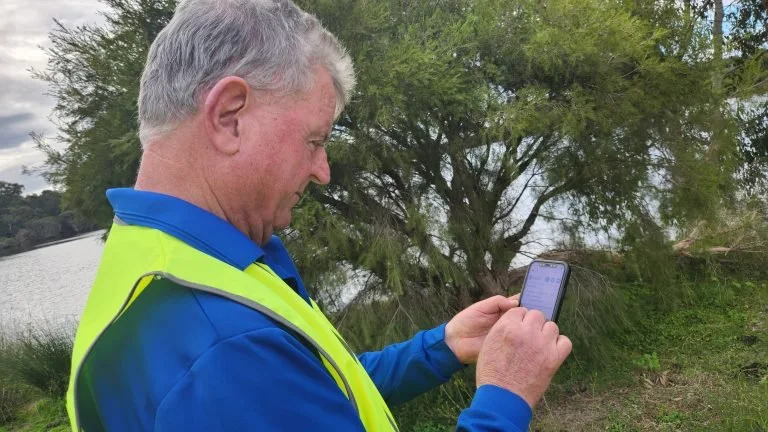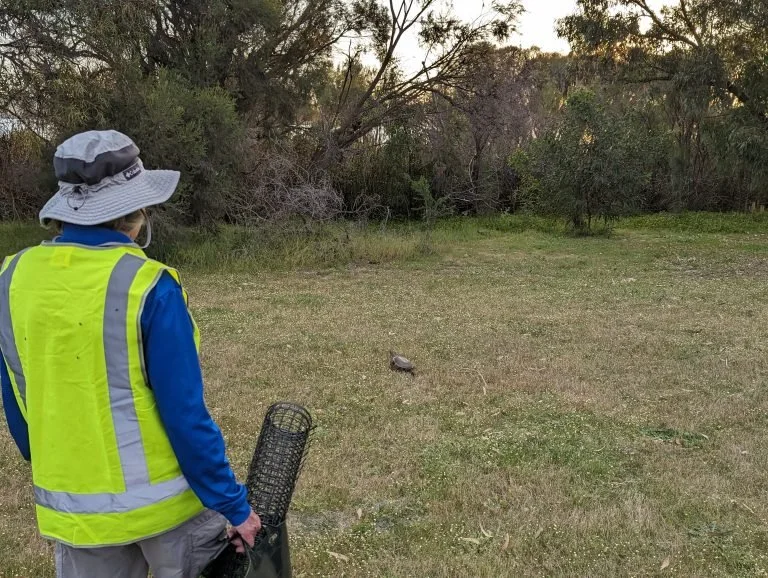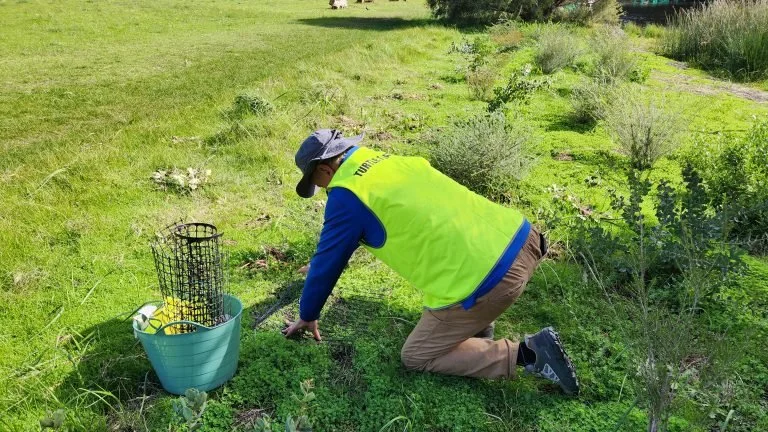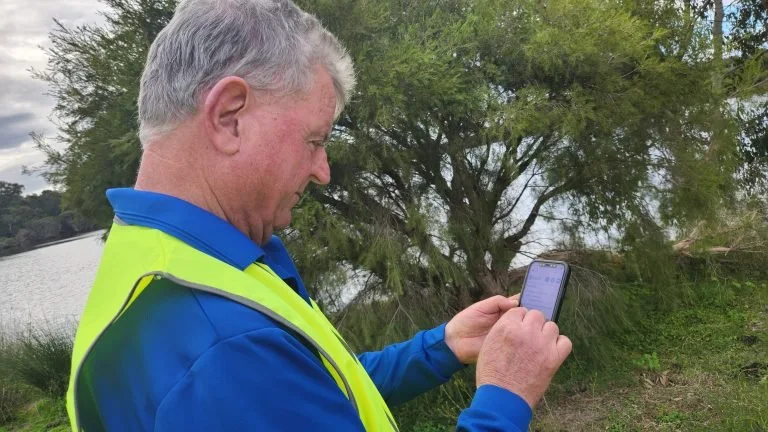Our amazing turtle tracking team in 2023/24. Bryan Saunders is pictured in the middle front with his hands in the air
Bryan and Jan Saunders have fallen in love with our cute, long-necked resident reptiles. We don’t blame them because how could you not fall in love with Southwestern snake-necked turtles?
Volunteers like Bryan and Jan, who dedicated their time to turtle tracking by walking around Lake Joondalup, spotting female turtles and protecting their nests, have contributed to saving 145 nests and 294 nesting female turtles through the City’s 2023 turtle tracking program.
With such great outcomes from last year’s nesting season, the City will be participating in the turtle tracking program for a second year in 2024, and we need more volunteers than ever to help save these fascinating turtles from becoming extinct.
Do you think you’ve got what it takes? Bryan and Jan think you definitely do.
Keep reading to learn more about a day in the life of a turtle tracker, the time involved, and what you might get up to when volunteering for such a beneficial cause.
Turtles face hurdles to lay their nests, and they need our help
Southwestern snake-necked turtles (Yaakan) are residents of Yellagonga Regional Park, but their numbers are in steady decline. They are very important animals in our wetland ecosystem as apex predators, and they are crucial for biodiversity and insect control. As a near-threatened species, they need our help to restore their populations.
Nesting season occurs from September through to November when mother turtles begin their risky journey to lay their eggs in a suitable nesting spot, which can often be up to 100 metres away from the lake’s edge. Female turtles often need to cross over footpaths and main roads to find a suitable spot to lay their eggs. As a result, nesting turtles and their hatchlings are susceptible to threats such as vehicle, bike or pedestrian strikes or predation from foxes, birds, dogs and cats as they make their way to/from the lake. Their nests are also often destroyed by birds and foxes.
The City joined the Saving our Snake-necked Turtle (SOSNT) project to help protect and restore turtle populations within Yellagonga Regional Park. The project is run in partnership with the City of Wanneroo and the Department of Biodiversity, Conservation and Attractions (DBCA) in collaboration with Murdoch University and the Perth South West Group, funded by Lotterywest.
As part of a Friends Group, Woodvale Waters Friends of Beenyup Channel, Bryan and Jan have first-hand experience seeing the predation of turtles and turtle nests. When they saw the City participating in the SOSNT turtle tracking program, they wanted to get involved and make a positive difference by doing what they could to save the turtles around Lake Joondalup and Beenyup Swamp.
A day in the life of tracking turtles
Being a trained Turtle Tracker involves working with the team to patrol the Yellagonga Wetlands and protect female turtles while they journey to find their perfect nesting spot and then back again to the lake. Turtle Trackers use materials to protect the nests, preventing them from being dug up and destroyed by predators such as cats and foxes.
For Bryan and Jan, turtle tracking was a project that fit perfectly into their pre-existing daily routine.
They were already enjoying a daily walk around the lake, so during the nesting season, they just ensured they were looking out for any turtles, covering nests and helping nesting turtles back to the lake.
Bryan and Jan dedicated about five hours per week to the program during the last season, but they note that other volunteers could opt to do only weekend work or a couple of hours here and there where it suited them. There was no time commitment required, and trained volunteers had access to a roster and simply filled out a time that worked for them each week.
Due to their experience managing volunteer work, Bryan and Jan went the extra mile. They did great work managing the volunteer roster for their area and filled in for volunteers who were not able to make their rostered times. They also kept spare materials at their house for volunteers to access in case they ran out.
During the nesting season, rainy days could trigger a ‘mass nesting’ event in the park, where many turtles could be on the move at one time. Bryan, Jan and other turtle tracker volunteers could dedicate extra time during these mass nesting events to help the female turtles make their journey to their nesting site. The online chat group helped communicate these mass nesting events to other volunteers, and it was a great opportunity for turtle trackers who had not yet seen a turtle come to the lake and help them.
Bryan and Jan also helped promote the Turtle SAT app and TurtleSAT website to encourage the wider community to record turtle and nest sightings. Anyone in the community can record this information, which is crucial for monitoring turtle populations throughout the park.
A volunteer project where you can see the difference
When asked about the most rewarding part of being involved in the program, Bryan said that the training session was valuable in helping them understand the scale of the issue and the population decline of turtles.
“Having that understanding helps really bring a sense of achievement when you do something as simple as walking with a female turtle back to the lake. It’s such a simple thing to do, but it is so rewarding, and the impact on future turtle generations can be huge.”
So, you want to be a turtle tracker?
“Becoming a turtle tracker is an easy and enjoyable way of helping our native critters and getting out into nature. Attending the turtle training session first is important as it gives you a full understanding of the significant issues turtles have to deal with and how we can help them,” says Bryan.
Now you’ve heard all the benefits – how can you get involved?
Turtle tracker volunteers must attend a compulsory turtle training session. Training sessions are run each year in winter in preparation for the Spring nesting season and ensure participants are legally permitted to be in contact with wildlife. This year’s session has taken place. The next training session will be scheduled for winter 2025.
Please visit our Events Calendar for other upcoming environmental events.
Learn more about our Southwestern snake-necked turtles, other ways to protect our wildlife, the wetlands in the City, and other wildlife warriors involved in the turtle tracker program.




